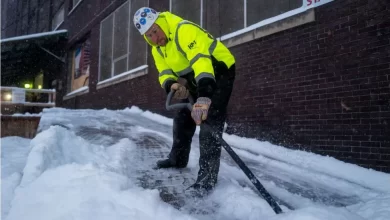Expanding Search Area and Growing Oxygen Concerns Prompt Titanic Sub Search Team to Take Action

In the effort to locate the missing submarine carrying five individuals who went on a dive to explore the Titanic wreck, rescue teams have expanded the search area, effectively doubling their efforts.
As the search enters a crucial stage, additional boats and underwater vehicles are being deployed on Thursday to aid in the search operation.
With the sub’s oxygen supply rapidly depleting, experts estimate that there are only a few hours remaining before it runs out completely, possibly around 10:00 GMT (06:00 EDT) on Thursday. However, the duration of the oxygen supply is influenced by multiple factors, as per expert opinions.
For the second consecutive day, sonar buoys – sound-detecting devices deployed from aircraft or vessels – have detected additional sounds, according to the US Coast Guard’s announcement on Wednesday.
During a press briefing held in Boston, Capt. Jamie Frederick revealed that a Canadian search aircraft had detected underwater sounds on both Tuesday and Wednesday.
As a result of this development, the search team has redirected its attention to the specific area where these sounds were identified.
According to Capt. Frederick, the nature of the detected sounds remains unknown, and the US Navy is assisting in their analysis. Despite conducting underwater searches in the area where the sounds were detected, no findings have been made thus far.
Additionally, with the arrival of additional boats and underwater vehicles, search operations will recommence in the initial search location. The total area being meticulously scoured at sea spans approximately 26,000 square kilometers (10,000 square miles), equivalent to twice the size of the US state of Connecticut.
Capt. Frederick expressed a persistent sense of optimism, stating, “Hope is ever-present,” while emphasizing that the ongoing operation is unequivocally focused on search and rescue.
At present, there are five surface vessels actively participating in the search, and an additional five vessels are en route to the designated area.
Simultaneously, the team plans to augment the underwater search efforts by introducing several more remotely-operated vehicles (ROVs) into the operation on Thursday morning.
“We are conducting the search in the specific area where the sounds were detected. Tomorrow morning, we will persist with our search in that location and deploy additional ROVs to the original search site,” Capt. Frederick explained.
Among the vessels en route to support the search operation is the French ship L’Atalante, equipped with a robot capable of reaching depths of 3,800 meters (12,500 feet) on the seabed. This vessel possesses the ability to lift the Titan submarine to the surface.
In an earlier statement on Wednesday, Rear Admiral John Mauger of the US Coast Guard mentioned that the submarine is presumed to be equipped with an emergency life-support system intended to supply oxygen. However, the available oxygen reserves were diminishing.
“The uncertainty regarding the rate of oxygen consumption per occupant on the submarine poses a challenge in accurately estimating the remaining oxygen levels,” explained Rear Admiral Mauger.
The 21-foot vessel carries a group consisting of British entrepreneur Hamish Harding, British-Pakistani entrepreneur Shahzada Dawood and his son Suleman, former French navy diver Paul-Henry Nargeolet, and Stockton Rush, the CEO of OceanGate, the company operating the submersible.
Nonetheless, Oisin Fanning, who has previously embarked on a deep-sea expedition to the Titanic wreckage and is acquainted with some individuals aboard the missing submersible, informed the BBC that the crew members possess the knowledge and experience to optimize their oxygen reserves.
According to Mr. Fanning, the individuals on board underwent thorough training in advance and will promptly implement measures to conserve oxygen as soon as possible.
According to Dr. Ken LeDez, an expert in hyperbaric medicine at Memorial University in St. John’s, Newfoundland, there is a possibility for the crew to survive despite the diminishing oxygen supply. The likelihood of survival would depend on factors such as the crew’s physical condition and the conditions within the submersible.
Although it is not possible to ascertain the precise circumstances inside the submersible, Dr. LeDez noted that the crew is likely to encounter rising carbon dioxide levels, potential exposure to cold temperatures, and the ongoing reduction in oxygen levels.
Dr. LeDez explained that the convergence of these factors may result in hypothermia and potential loss of consciousness. However, he clarified that these conditions do not automatically guarantee fatality. In fact, the crew’s metabolic rate slowing down due to the cold environment could potentially aid in prolonging their survival.
“Dr. LeDez expressed his confidence in the crew’s capabilities, referring to them as highly intelligent and accomplished individuals. He stated that if anyone has the ability to endure the situation, it would be these particular individuals.”




